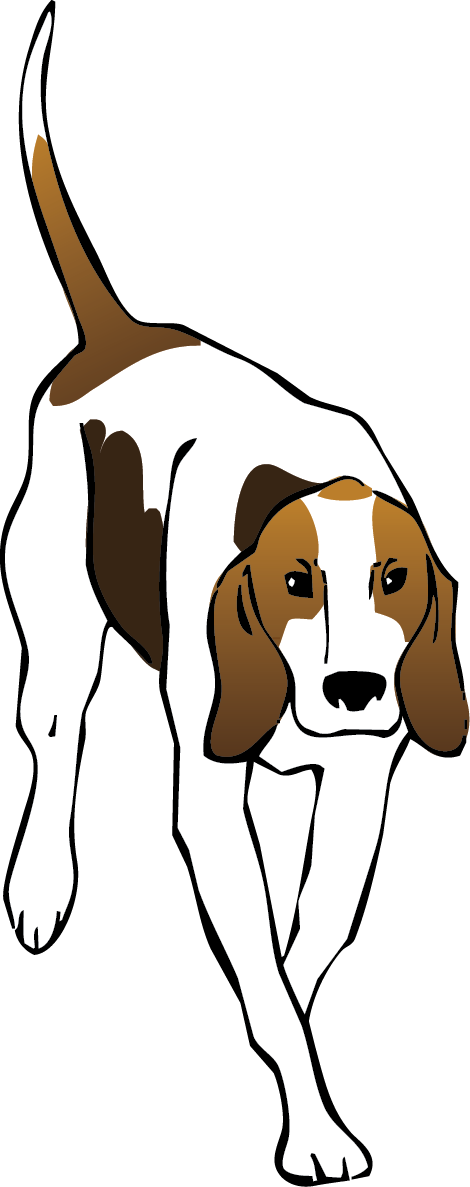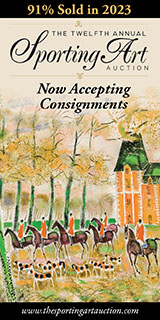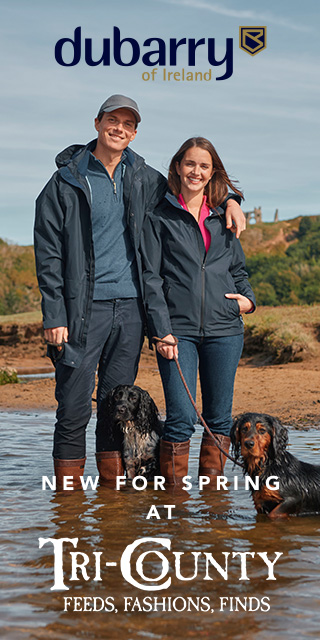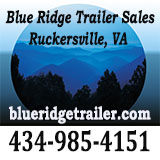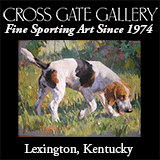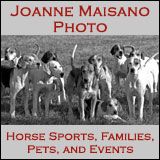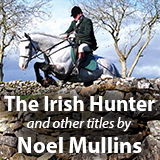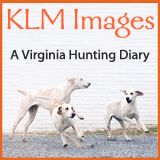Blue Ridge Hunt
Orange County Pimple Is Grand Champion at Bryn Mawr
Orange County Pimple 2019 / Karen Kandra photo
Orange County Pimple overcame the burden of her name to be judged Grand Champion of Show at the 2022 Bryn Mawr Hound Show held at the Radnor Hunt Club on Saturday, June 4, 2022.
First held in 1914, this is the oldest and longest-running hound show in North America. Hounds are shown in six rings: English Foxhounds, American Foxhounds, Crossbred Foxhounds, Penn-Marydel Foxhounds, Beagles, and Bassets.
Judges for the final Grand Champion Class were Charlotte Buttrick, ex-MFH, Farmington Hunt (VA), and Coleman Perrin, Ex-MFH, Deep Run Hunt (VA).
Blue Ridge Hunt Point-to-Point
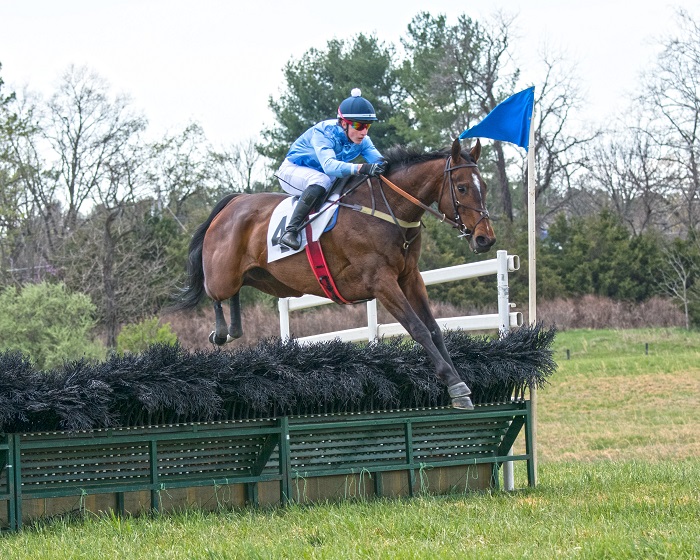 Jump race jockey Teddy Davies, a teenager, already a record holder, and having a breakout season in sanctioned racing. Here, Davies rides Brave Deacon in the second race at Blue Ridge, Amateur/Novice Rider Hurdles. / Joanne Maisano photo
Jump race jockey Teddy Davies, a teenager, already a record holder, and having a breakout season in sanctioned racing. Here, Davies rides Brave Deacon in the second race at Blue Ridge, Amateur/Novice Rider Hurdles. / Joanne Maisano photo
Trainer Joseph Davies stood at the Entry desk on Sunday, April 17, 2022. It was at Woodley Farm near Berryville, Virginia, the traditional venue for the Blue Ridge Hunt Point-to-Point Races. Davies trains racehorses for steeplechasing but was in earlier days a winning steeplechase jockey himself. And a two-time winner of the Maryland Hunt Cup, the stiffest timber race in the world. Davies was paying for his race entries and picking up the numbered saddle cloths.
A few other trainers waited their turn. “Congratulations, Joe, on your wins yesterday. And here you are again today!”
A Storybook Pack
Each hound in this pack is a top-ten qualifier from one of nine qualifying foxhound performance trials held across North America this season.
 Trial Huntsman Epp Wilson and his guide, huntsman Graham Buston, in the Blue Ridge country / Joanne Maisano photo
Trial Huntsman Epp Wilson and his guide, huntsman Graham Buston, in the Blue Ridge country / Joanne Maisano photo
This Blog is to celebrate an exclusive pack of foxhounds that will hunt the fox at the J. Robert Gordon Field Trial Grounds in Hoffman, North Carolina, from March 25−27, 2022. The hound that earns the top score in this trial will be named the 2022 National Champion Performance Trial Foxhound.
Each hound in this unique pack earned its place by qualifying in one or more two-day performance trials held over this season from coast to coast. To qualify for this, the National Championship Performance Trial, each hound here compiled a score during its qualifying trial that placed it among the top-ten scoring hounds in that trial.
Why should that matter to hunt officers, Masters, huntsmen, hound breeders, and field members?
Cleveland Bay Hunting Action at Farnley
Video by James Tonery
Farnley Farm in White Post, Virginia, and the Blue Ridge Hunt hosted seventeen Cleveland Bays and Cleveland Bay crosses for their annual reunion hunt. Representatives of the breed―all plain bays!―arrived from all points of the compass on November 13, 2021, and enjoyed a spectacular day of hunting.
Farnley is an entirely appropriate fixture for this annual reunion of Cleveland Bay horses and meeting of the Blue Ridge hounds. In the 1930s, Farnley was home to the late Alexander Mackay-Smith and where he bred the first Cleveland Bays to be foaled in America.
Bull Run/Blue Ridge Foxhound Performance Trial
Middleburg Brings a Lovable Veteran; Blue Ridge Shows Depth
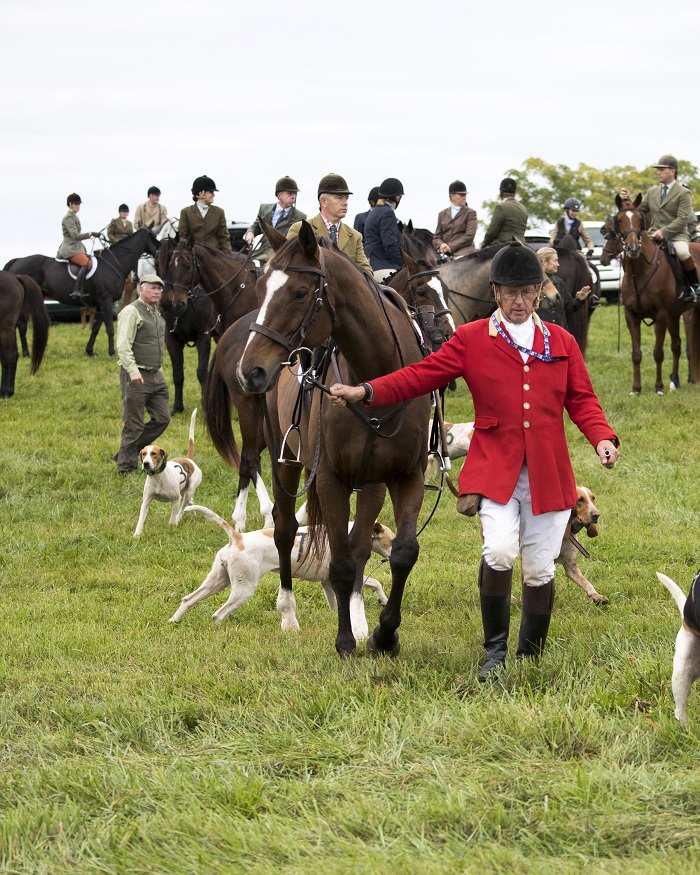 Trial Huntsman Epp Wilson, MFH, Belle Meade, leading hounds, is ready to mount up and move off for the second day of the Bull Run/Blue Ridge Performance Trials. Directly behind is his guide through the country, Blue Ridge huntsman Graham Buston. Judge Grosvenor Merle-Smith, ex-MFH, is on foot. The faces visible behind Grosvenor are (l-r) Lindsay LeHew, her father, Jeff LeHew, MFH, Blue Ridge, Anne McIntosh, MFH, Blue Ridge, and whipper-in Ross Salter. / Joanne Maisano photo
Trial Huntsman Epp Wilson, MFH, Belle Meade, leading hounds, is ready to mount up and move off for the second day of the Bull Run/Blue Ridge Performance Trials. Directly behind is his guide through the country, Blue Ridge huntsman Graham Buston. Judge Grosvenor Merle-Smith, ex-MFH, is on foot. The faces visible behind Grosvenor are (l-r) Lindsay LeHew, her father, Jeff LeHew, MFH, Blue Ridge, Anne McIntosh, MFH, Blue Ridge, and whipper-in Ross Salter. / Joanne Maisano photo
The fourth Foxhound Performance Trial of the 2021/2022 season was hosted jointly by the Bull Run Hunt and the Blue Ridge Hunt in Virginia. Hounds hunted on Saturday, October 23, 2021, in the Bull Run hunting country of open farmland, fields, and woods, followed by dinner and first-day awards. On Sunday, October 24, hounds hunted in the Blue Ridge country by the western banks of the Shenandoah River through open flood plains, over scarcely negotiable cliffs above the river, through woods, and across open farmland.
Hounds from eight hunts competed: Blue Ridge Hunt, Bull Run Hunt, Deep Run Hunt (VA), Farmington Hunt (VA), Marlborough Hunt (MD), Middleburg Hunt (VA), Rappahannock Hunt (VA), and Thornton Hill Hounds (VA).
Blue Ridge Opening Meet Returns to Historic Carter Hall
 1987 Blue Ridge Opening Meet at Carter Hall. Master and Staff: (l-r) Robert J. Pillion, honorary whipper-in, Mrs. George P. Greenhalgh, Jr, MFH, Christopher P. Howells, huntsman, and Clifford J. Hunt, honorary whipper-in. Fieldmembers: Mrs. Roy Batterton, Field Master, Mrs. Hobart Bauhan, Dr. Alfred Berz, Mrs, Jean-Claude Buffeault, Miss Leslie Bowery, Mrs. Robert Chandler, Cynthia Coates, Peter Cook, Georgia Crawford, Mr. and Mrs. Walter Donaghy, Mimi Donovan, Mrs. A.R. and Molly Dunning, Gray Farland, Mr. and Mrs. Norman Fine, Caj Haakenssen, Katie Henke, Mrs Clifford Hunt, Herbert Jonkers, Ann-Estelle Jung, Peter Levendis, Dr. and Mrs. Matthew Mackay-Smith, Philip T. McIntyre, Mr. and Mrs. Leander McMillen, Mrs. Walter Nalls, Sara Ohlidal, Allyn Patterson, Mrs. Robert and Sarah Pillion, Dr. and Mrs. Marc Read, Mrs. William Smythe, Mr. and Mrs. John Staelin, Mrs. Harry Stimson, III, Richard Sullivan, and Harold Van der Wilt.
1987 Blue Ridge Opening Meet at Carter Hall. Master and Staff: (l-r) Robert J. Pillion, honorary whipper-in, Mrs. George P. Greenhalgh, Jr, MFH, Christopher P. Howells, huntsman, and Clifford J. Hunt, honorary whipper-in. Fieldmembers: Mrs. Roy Batterton, Field Master, Mrs. Hobart Bauhan, Dr. Alfred Berz, Mrs, Jean-Claude Buffeault, Miss Leslie Bowery, Mrs. Robert Chandler, Cynthia Coates, Peter Cook, Georgia Crawford, Mr. and Mrs. Walter Donaghy, Mimi Donovan, Mrs. A.R. and Molly Dunning, Gray Farland, Mr. and Mrs. Norman Fine, Caj Haakenssen, Katie Henke, Mrs Clifford Hunt, Herbert Jonkers, Ann-Estelle Jung, Peter Levendis, Dr. and Mrs. Matthew Mackay-Smith, Philip T. McIntyre, Mr. and Mrs. Leander McMillen, Mrs. Walter Nalls, Sara Ohlidal, Allyn Patterson, Mrs. Robert and Sarah Pillion, Dr. and Mrs. Marc Read, Mrs. William Smythe, Mr. and Mrs. John Staelin, Mrs. Harry Stimson, III, Richard Sullivan, and Harold Van der Wilt.
History and tradition are synonymous with the Blue Ridge Hunt (VA). The hunt was established in 1888 and has been an enduring, influential, and visible institution in Clarke Country ever since.
On Saturday, October 30, 2021, the hunt’s Opening Meet will once again, after a hiatus of twenty-six years, take place at Carter Hall. Opening Meets had been held at Carter Hall since the mid-1930s.
Performance Trial Hounds to Vie for National Championship
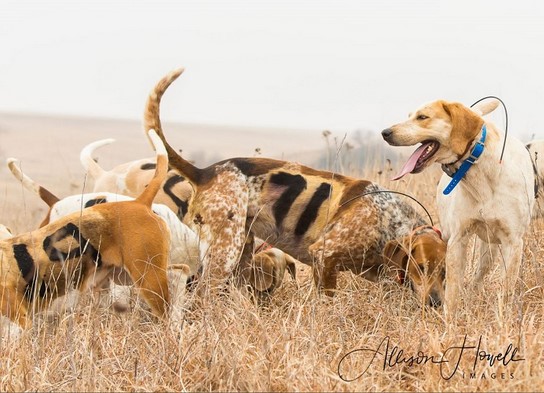 Mission Valley 2018 Performance Trials: Fort Leavenworth Tracker 2010 (#71) was overall High Point foxhound after two days of hunting. / Allison Howell photo
Mission Valley 2018 Performance Trials: Fort Leavenworth Tracker 2010 (#71) was overall High Point foxhound after two days of hunting. / Allison Howell photo
The schedule of Foxhound Performance Trials for the 2021/2022 foxhunting season has been released by Trial Chairman Fred Berry, MFH, Sedgefield Hounds (NC). Nine qualifying trials will be run across the country, and the tenth and final trial will crown a Grand Champion and the top ten performance hounds in North America.
"'Pretty is as pretty does' really applies to foxhounds," says Fred. The Brits invented mounted foxhunting and hound show, but they shouldn’t have stopped there.
Bespoke Hunting Attire: Part 1
The Art of Making
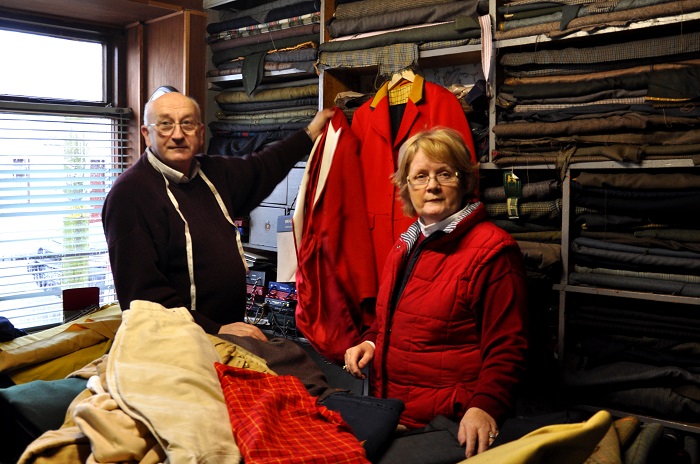 Michael and Elsie Frazer in their bespoke tailoring shop in the village of Hospital, Ireland / Noel Mullins photo
Michael and Elsie Frazer in their bespoke tailoring shop in the village of Hospital, Ireland / Noel Mullins photo
I read a report recently in The Sunday Times that ‘Fast Fashion,’ a term for the impulse buying of clothes online and in stores that people wear just a few times and then discard, contributes 1.2 billion tons of greenhouse gas emissions each year into the atmosphere. In the USA alone, 13 million tons of clothing are thrown into landfills or burned. In the UK, 300,000 tons of clothing end up in landfills, an interesting statistic in that the public is often led to believe, incorrectly, that farmers are to blame for all the unwanted emissions.
Those in the hunting fields, however, used to see family after family who wore hunting attire passed down from prior generations. What was their secret?
The Closing of a Literary Institution: An Opportunity for Readers and Collectors
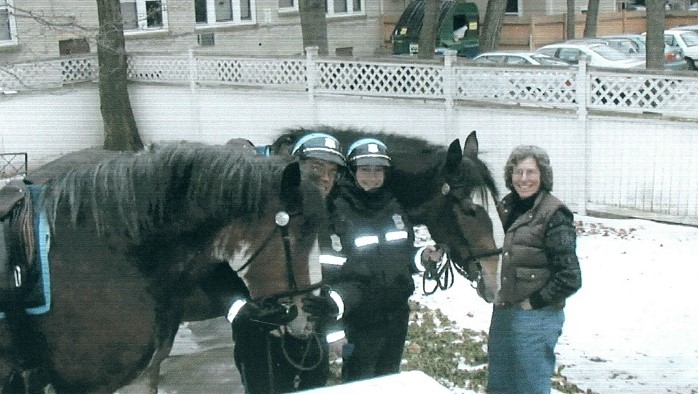 Robin Bledsoe, bookseller, at right with customers...two members of the mounted police force...in the backyard of her bookshop in Cambridge, Massachusetts.
Robin Bledsoe, bookseller, at right with customers...two members of the mounted police force...in the backyard of her bookshop in Cambridge, Massachusetts.
Robin
As I close my bookshop and open a new chapter in my bookselling career, Norm has asked me to say a few words about my almost half century of selling horse books.
Ever since I received Somebody’s Pony for Christmas 1952, I’ve cherished and collected horse books. After earning an M.A. in art history and starting a publishing career, I began selling out-of-print books in my two fields of interest, horses and art. I named the business Blue Rider Books after a group of German artists who often painted horses. I found some books in nearby book barns, ran some classified ads, mailed out a list, and so it all began—100-plus catalogues, dozens of trade fairs and horse shows, and tens of thousands of books ago.
The Vixen’s Meet: A Fund Raiser for Our Times
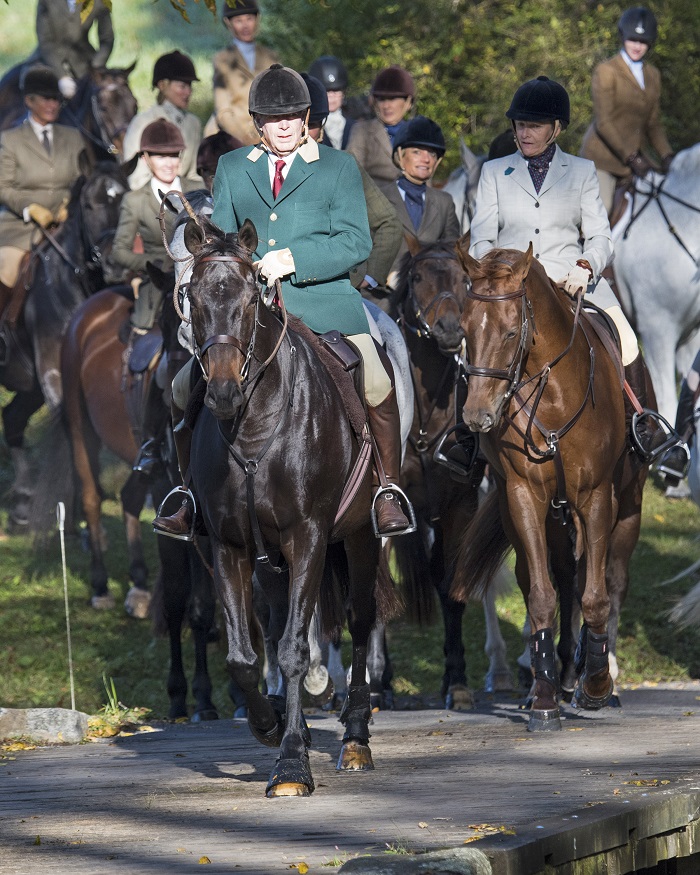 Orange County Hounds Field Master John Coles, MFH, leads a field of 60 visiting foxhunting ladies on the Vixen's Meet . / Joanne Maisano photo
Orange County Hounds Field Master John Coles, MFH, leads a field of 60 visiting foxhunting ladies on the Vixen's Meet . / Joanne Maisano photo
When the COVID pandemic and executive orders from the Governor of Virginia forced cancellation of Orange County Hounds’ primary annual fund raising event—the barn party held at Board President Jaqueline Mars’ legendary home—OCH Board leaders Jane Bishop and Emily Hannum put their heads together and scheduled instead a Vixen’s Meet. Given the strong showing October 15, 2020 at Stonehedge in The Plains, Virginia, the ladies like it.
Ladies from a dozen hunts turned out in support of Orange County: Belle Meade Hunt (GA), Mr. Stewart’s Cheshire Foxhounds (PA), Cloudline Hounds (TX), and De La Brooke Foxhounds (MD). From Virginia were ladies of the Blue Ridge Hunt, Casanova Hunt, Loudoun Fairfax Hunt, Middleburg Hunt, Piedmont Fox Hounds, Rappahannock Hunt, and Snickersville Hounds.
